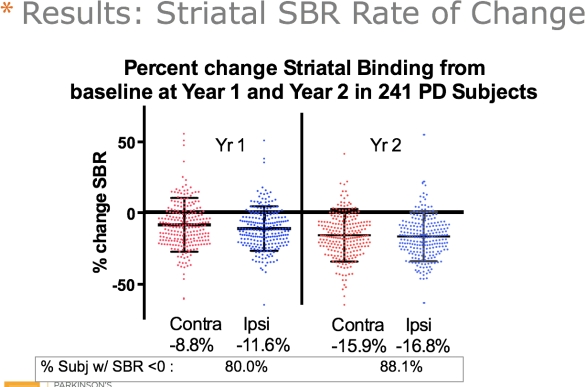Session Information
Date: Tuesday, June 21, 2016
Session Title: Parkinson's disease: Pathophysiology
Session Time: 12:30pm-2:00pm
Location: Exhibit Hall located in Hall B, Level 2
Objective: To evaluate subregion-dependent striatal changes in dopamine transporter (DAT) binding using 123-I Ioflupane SPECT in PD participants in the Parkinson Progression Marker Initiative (PPMI) study.
Background: Clinical measures of Parkinson’s disease progression suggest a slow process with significant variability between patients and over the course of disease. A number of “objective” imaging and non-imaging measures have been proposed as putative progression biomarkers although there is limited validation data. The PPMI study is an international longitudinal evaluation of biomarkers in a progressing early Parkinson’s disease population. Scintigraphic biomarkers are being evaluated as indicators of progression including the dopamine transporter (DAT) imaging with 123-I ioflupane SPECT.
Methods: Baseline (n= 241), 1 year, and 2 year 123-I Ioflupane SPECT scans were acquired from 22 centers. Data were reconstructed, attenuation corrected, and analyzed by the core lab using a volume of interest template for extraction of counts in the left and right caudate and putamen. Specific binding ratios (SBRs) were calculated and percent SBRs changes in three striatal subregions assessed.
Results: Serial evaluation using quantitative DAT measures show reduction at 1 yr in 80% of 241 PD subjects. Specific binding ratios demonstrate 11.6% and 7.4% reductions over one year in the ipsilateral and contralateral striatum, respectively. Regional differences in the rates of DAT signal change are evident in subregions of the striatum. The fastest rates of change over one and two years were noted, in order in ipsilateral striatum; posterior putamen, anterior putamen, and caudate. In contrast, the contralateral posterior putamen demonstrated the slowest rates change followed by the anterior putamen and the caudate. 
Conclusions: These data support the potential use of dopamine transporter imaging as a serial marker of change in a longitudinal Parkinson’s cohort. Specifically, areas with greatest signal change and lowest variability might be more sensitive to detecting slowing rates of change with a disease modifying therapy. In summary, these studies show consistent and increasing signal loss over one and two years with regional differences demonstrated for DAT imaging and confirmation of previously noted between subject variability.
To cite this abstract in AMA style:
J.P. Seibyl, D. Jennings, K. Marek. Evaluation of regional changes in striatal DAT binding in a progressing Parkinson’s disease (PD) cohort: Lessons for imaging biomarker assessment in disease-modifying therapeutic trials [abstract]. Mov Disord. 2016; 31 (suppl 2). https://www.mdsabstracts.org/abstract/evaluation-of-regional-changes-in-striatal-dat-binding-in-a-progressing-parkinsons-disease-pd-cohort-lessons-for-imaging-biomarker-assessment-in-disease-modifying-therapeutic-trials/. Accessed April 18, 2025.« Back to 2016 International Congress
MDS Abstracts - https://www.mdsabstracts.org/abstract/evaluation-of-regional-changes-in-striatal-dat-binding-in-a-progressing-parkinsons-disease-pd-cohort-lessons-for-imaging-biomarker-assessment-in-disease-modifying-therapeutic-trials/
